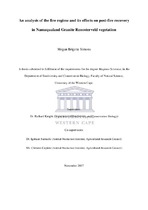An analysis of the fire regime and its effects on post-fire recovery in Namaqualand Granite Renosterveld vegetation
Abstract
Namaqualand Granite Renosterveld (NGR) is a fire-prone shrubland largely confined to the
Kamiesberg Uplands. More than 20% has been transformed by agricultural activities such as
grazing and dryland cropping. The history of fires of Namaqualand Granite Renosterveld was
assessed over a period from 2000 - 2015. Furthermore, this study aimed to assess the effects
of fire and grazing on the dynamics of Elytropappus rhinocerotis and the post-fire vegetation
recovery. Satellite imagery, field observations and combination of field sampling techniques
were used to compile a comprehensive fire database and to collect data on vegetation
parameters. The Kamiesberg Uplands has a human-induced fire regime with a fire frequency
of 4.2 years, which appears to be shorter for NGR compared to other Renosterveld - types. The
majority of the fires were in summer and early autumn which is the ecologically accepted
season with high fire intensities. Fire Danger Index ratings for summer burns were in the
dangerous and very dangerous categories. In terms of cover, the distances between E.
rhinocerotis individuals were significantly more on the burnt than on the unburnt sites. The
density of unpalatable species on the burnt sites is also strongly associated with E. rhinocerotis.
Elytropappus rhinocerotis appears to facilitate a role as a nurse-plant for various species in
renosterveld. The local biotic and abiotic conditions, allows E. rhinocerotis to maintain its
abundance, thus displaying niche construction by a single species.

